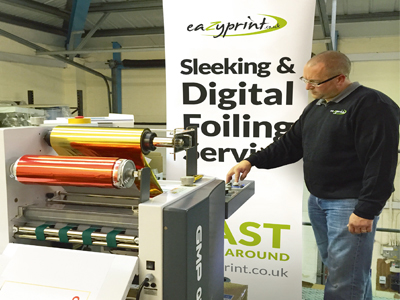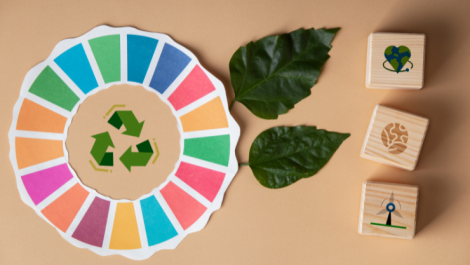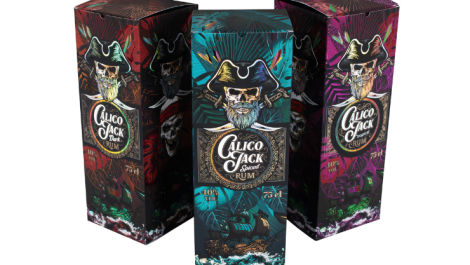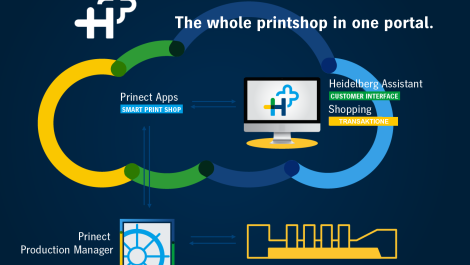Eazyprint in Northamptonshire is the first to be using a new combination of GMP laminating machine and films to achieve a range of special variable data ‘sleeking’ effects.
Sleeking is not a word you will find in any dictionary, but it is something that is making a big difference to business at Eazyprint in Corby, Northants. The word has been coined by Korean laminating systems and films manufacturer GMP (which is represented in the UK by GMP UK) due to the shiny and ‘sleek’ effects its Q-Topic 380 laminating system and special laminating films can deliver. Gold and silver foiling and holographics are among these effects, and the sheets can then be put back through a digital press for additional printing. Family business Eazyprint has the first of these laminating systems in the UK.
One of the two brothers running the company with their mother is Daniel Pretot, who has been enjoying experimenting with the combination of laminator, film and digital press to see what can be achieved. While GMP attaches the word sleeking to all of these effects, Mr Pretot is rather more selective.
‘If I’m going to foil something, I call it foiling. To me, the sleeking aspect is when you do what someone would call a spot UV,’ he said. ‘If you laminate something, it’s the whole sheet. This looks like a gloss laminate but it has a backing that goes on a take-up roller.’
GMP UK’s managing director Mark Dinsdale added: ‘The Q-Topic 380 has features that allow digital printers to start doing things a little differently. They can do variable data effects and also print on top of them digitally. The magic is in the film but it’s not just about putting in an offline winder to take it away, it’s getting the right pressure with the right rollers. You can get very fine detail. It is also inexpensive: an A4 sheet with full coverage will be a few pennies.’
The biggest bonus, according to Mr Pretot, is that using the GMP combination of laminator and films enables variable data digital foiling. ‘We told a customer that we can do variable data with foil and they said they had been looking for that for ages,’ he said. He sees it being particularly useful for a wide range of event and wedding stationery as well as jobs such as foiled certificates, menus and business cards. It is a perfectly good laminator for general work also, he added, and can be operated by one person, but its capabilities are far greater and are still being discovered as Eazyprint uses the system.
‘As you go along you sometimes think, I wonder what would happen if we did that?’ said Mr Pretot. ‘It becomes experimental. You do something and think: I like that, I will keep it. We have done holographic with silver and soft touch lam. If a customer wants something out of the ordinary, something special for a special day, and they are prepared to pay a little bit more, you can achieve some really good effects.’
GMP laminators were not new to the company, but when Eazyprint was looking to upgrade its old system, it heard from GMP that a new machine was coming onto the market which was able to offer these effects. Mr Pretot continued: ‘It sounded very interesting. They said it could do foil and I thought, that could be good. Everything else comes after that: foil, holographic, spot UV, print on top of the foil, matt and gloss sleeking. There are so many different effects that you can now have along with matt and gloss.’
The Q-Topic 380 costs less than £10,000. It is easy to use and changing over between different films is a quick process. The sleeking films are similar to traditional laminating films except that the OPP or polyester part is purely a carrier and is removed after laminating, leaving a seven or eight micron thick foil layer which, according to Mark Dinsdale, is more like a resin coating than a film. ‘That’s why it won’t lift when you crease the paper,’ he added. ‘It’s like a liquid coating.’
GMP’s intention is to introduce more laminating systems that are capable of the sleeking effects, and it will be showing the Q-Topic 380 to the UK market at The Print Show at the NEC in October. It also has a patented process called Clear Fold, aimed at the layflat photobook sector, in which sheets are slit to make the hinge of the photobook as they are laminated. This will mean that instead of having to buy specific paper for a layflat product, printers can use their preferred stocks.





